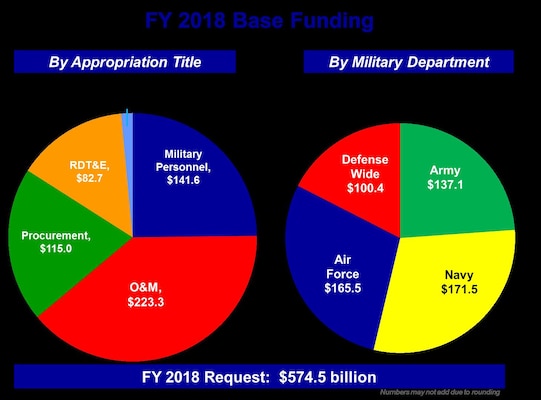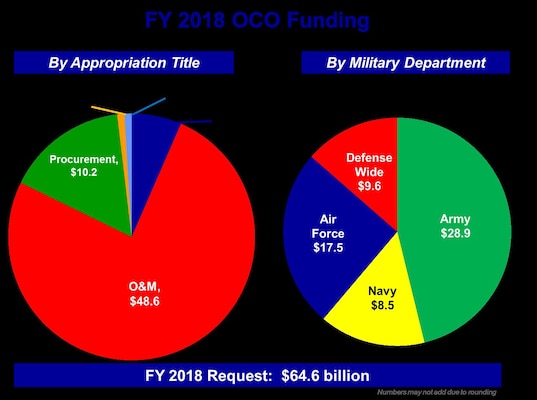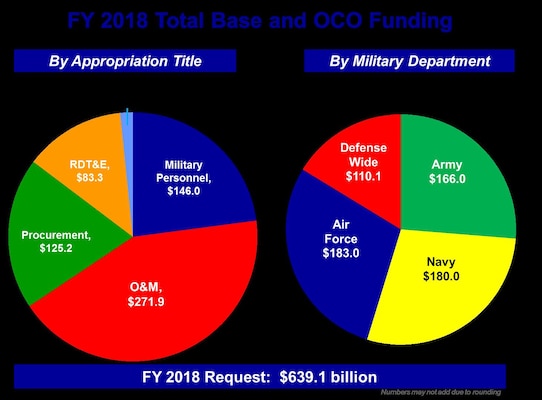Today President Donald J. Trump sent Congress a proposed budget request of $639.1 billion, $574.5 billion in the base budget and $64.6 billion in the Overseas Contingency Operations (OCO) budget.
This budget request is $52 billion above the defense budget cap in the Budget and Control Act (BCA) of 2011.
This funding is required to continue to rebuild warfighting readiness and will restore program balance by fixing the holes created by previous budget cuts.
Since enactment of the BCA, the world has become more dangerous.
Over this period, the military has become smaller and training, maintenance, and modernization have been deferred, resulting in degraded warfighting readiness.
This budget request reverses that degradation and starts restoring the readiness of our armed forces to meet the challenges of today and the future.
To do so, it is essential that the defense sequestration caps be reversed.
As Secretary Mattis recently told members of Congress, the BCA and sequestration have “done more damage to our readiness than the enemies in the field.”
(Hear from Sec. James Mattis. Senate Appropriations subcommittee hearing on Trump’s proposed defense budget. March 22. 2017. Courtesy of CHANNEL90seconds newscom and YouTube)
The funding in the OCO budget provides resources in support of Operation Freedom’s Sentinel (OFS) in Afghanistan, Operation Inherent Resolve (OIR) in Iraq and Syria and other global counterterrorism operations.
In addition, the funds enhance U.S. assurance and deterrence in Eastern Europe through the European Reassurance Initiative (ERI).
The FY 2018 budget request is the second step in a three-step process to rebuild the Armed Forces.
The first step was the FY 2017 Appropriations Act.
That money is for immediate warfighting readiness shortfalls and funds the increased operating tempo in the fight against the Islamic State of Iraq and Syria (ISIS).
This request builds on those resources and focuses on restoring a balanced defense program.
The FY 2018 budget request includes:
- Sustainment of the increased manning levels for the Army and Marine Corps in the FY 2017 National Defense Authorization Act as well as increases in Air Force and Navy manning levels.
- Additional funding for operating forces, logistics, maintenance, training and spares
- Additional shipyard capacity and aviation depot maintenance for the Navy
- Increased unit and flight training for the Army
- Increased weapons sustainment and increased end strength to address pilot and maintainer shortfalls in the Air Force
- Increased investment in a wide range of preferred munitions
- Increased facilities sustainment, restoration and modernization across all Services
This budget request also invests in modernization and advanced capabilities to reassert our technological edge over future adversaries.
Major investments include:
- F-35 Joint Strike Fighter, 70 aircraft; $10.3 billion
- KC-46 Tanker, 15 aircraft; $3.1 billion
- B-21 Bomber, $2.0 billion
- Virginia Class Submarine, 2 ships; $5.5 billion
- DDG-51 Destroyers, 2 ships, $4.0 billion
- CVN-78 Class Aircraft Carrier, 1 ship, $4.6 billion
- Joint Light Tactical Vehicle, 2,647 vehicles; $1.1 billion
- Science and Technology, $13.2 billion
(Defense Secretary Jim Mattis and Marine Corps Gen. Joe Dunford, chairman of the Joint Chiefs of Staff, testify on military readiness at a Senate Appropriations Committee hearing in Washington, March 22, 2017. Courtesy of Bridget Bosch and YouTube)
The military and civilian personnel are the foundation of the Department and constitute its premier asset.
They have the full support of the Nation to accomplish the arduous mission of defending the United States of America.
This budget includes a 2.1% pay raise for military personnel and a 1.9% pay raise for civilian personnel.
The budget supports a competitive compensation package that reflects the unique demands and sacrifices of our service members.
The Department continues to seek compensation reforms that will:
- Expand access to telehealth and nurse advice lines
- Exempt medically retired and family members of those who die on active duty from cost share increases
- Incentivize members to make effective choices between mail order versus retail pharmaceuticals
- Modify blended retirement system to allow enlisted members beyond 26 years to receive government contributions under the Thrift Savings Plan
The Department continues to support a wide range of family support programs, such as:
- Non-medical counseling services
- Financial readiness training
- Joint Family Support Assistance through Military One Source
- Family Advocacy Program
- Military Spouse Education and Career Assistance
- Tuition Assistance for Off-Duty Education Support
- Child and Youth Programs
The FY 2018 budget request also continues the broad institutional reform agenda, which will:
- Continue the effort to reduce major headquarters activities staffs and overhead by 25%
- Continue acquisition reform
- Begin a full financial statement audit
- Reorganize the acquisition management function
- Establish a chief technology officer
- Establish a chief acquisition and sustainment officer
- Elevate the Cyber Command
- Seek authority to commence a new Base Realignment and Closure (BRAC) round in Fiscal Year 2021
The third step is the approval of the FY 2019 budget (and beyond).
This budget will be the first budget informed by the new National Defense Strategy that the Department is currently developing.
With that strategy in hand, the Department will be able to determine the budget needed to rebuild capacity and lethality across the Joint Force.
Highlights of the proposed budget are outlined in the charts below.
The entire budget proposal and additional material are available at http://comptroller.defense.gov/budgetmaterials.aspx.
|
FY 2018 Base Funding Graphic
|
FY 2018 OCO Funding Graphic
|
|
FY 2018 Total Base and OCO Funding Graphic
|
|




















